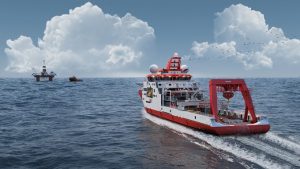Today the Internet is inundated with various articles providing guidance on CV writing; and almost all of them agree on the one thing: there is no universal resume template. Each industry has its peculiarities and in some cases very specific requirements for this document. For instance, it is a common knowledge that shipping industry leans toward an application form as a priority CV format. Meanwhile, it appears that writing a good seafarer application form might contain a lot of pitfalls. Below we have compiled a number of general recommendations for successful resume writing specific for maritime jobs.
Cover Letter and Application Form Tips
1. Put yourself in the shoes of crewing specialist who should handle dozens of application forms which come in response to the posted vacancies for seafarers. Naturally, the first priority will be given to those files which names match the vacancy as closely as possible. So, there comes the first rule, a resume file should have the name that corresponds with the position you are applying for.
 For example, if you submit your application form for the position of AHTS Master, the name the file will be: CV_ MA_AHTS_Name.pdf. This way it instantly becomes clear that the attached file contains a resume; the sender is Captain and his key expertise is AHTS vessels. In addition, such a wording helps to find your file in the search, if need be.
For example, if you submit your application form for the position of AHTS Master, the name the file will be: CV_ MA_AHTS_Name.pdf. This way it instantly becomes clear that the attached file contains a resume; the sender is Captain and his key expertise is AHTS vessels. In addition, such a wording helps to find your file in the search, if need be.
2. The first thing that crewing manager should see by opening the email is a beautifully written accompanying letter. If put together correctly it is usually of moderate size and contains information explaining why candidate is interested in a particular job or company. In addition, cover letter briefly lists professional achievements, eye-catching certificates and skills. Always choose only standard font and spacing for this accompanying text; please mind that any bright colors, frames, italics and so on will be treated as a bad form and, therefore, are completely unacceptable here.
3. Thus, let’s look closely at the application form itself. It should begin with a clear business-like photo of the candidate and his briefly stated contact details. Rank and preferable salary are also placed at the top of the document. (Please note that the photo usually makes the resume more personalized and attractive; however, if you are not in possession of the right one, it is far better to send the form without the picture than with a photo that is likely to mar the impression of you).
Describing Sea Service Correctly
 4. Next and, perhaps, the most important paragraph of the application form is the working experience. Always start with your last trips as they interest representatives of crewing and shipping companies most. State clearly positions onboard, names and types of vessels (and engines), dates of your trips and names of shipowners. Ideally, your sea service should be solid and without long onshore interludes between contracts. If there were any career breaks then you should be able to come up with a reasonable explanation as the recruiter will certainly pay attention to these circumstances. Also, the prospective employer might be alerted by the too frequent change of companies.
4. Next and, perhaps, the most important paragraph of the application form is the working experience. Always start with your last trips as they interest representatives of crewing and shipping companies most. State clearly positions onboard, names and types of vessels (and engines), dates of your trips and names of shipowners. Ideally, your sea service should be solid and without long onshore interludes between contracts. If there were any career breaks then you should be able to come up with a reasonable explanation as the recruiter will certainly pay attention to these circumstances. Also, the prospective employer might be alerted by the too frequent change of companies.
On the other hand, if you were promoted during your time onboard, don’t forget to reflect it in your CV.
If you describe your experience in detail specifying your responsibilities onboard, try to avoid trivialities and repetitions; elaborate only the experience that is unique for every vessel. Meaning, that if you are Chief Mate it is obvious that you will be in charge of organizing navigational watch every time you happen to be onboard. However, in course of some particular voyage you might have acquired some unique cargo handling experience; navigated in arctic regions or pushed your vessel through a complex audit. These are the points which are worth mentioning.
Trainings, Certificates and Higher Education
5. It is no secret that the availability of necessary certificates is often as crucial in the shipping industry as the required working experience. Therefore, one should never underestimate the importance of this paragraph. Useful tip, when listing your certificates, check the spelling with the original or on the Internet.
Remember that text editors that check spelling automatically will miss abbreviations so often used in maritime documents. You won’t want to find yourself at risk of blotting your copybook for your future employer if, for instance, ‘BOCIET‘appears on your resume. For a recruiter who has noticed such a mistake you will immediately downgrade to careless person or candidate with a poor English language knowledge. In both cases your chances to get a job won’t be increasing.
Personal Data, Languages and Hobbies
6. Since nationality and date of birth are always quite important for the recruiter, it is a good idea to place them at the top of the application form to save crewing manager the trouble of looking for this information. Meanwhile, such details as marital status, biometric data, etc. should better appear at the very end of the document. Be sure to specify your level of English and availability of Marlins certificate (if you are in possession of one) with an indication of gained percentage.
At the same time, mind, that information about hobbies is in most cases irrelevant. Recruiters are not interested in this bit. Incidentally, this applies both for maritime and onshore professions.
 Speaking about the English language level, it is quite obvious that a successful resume should not contain any spelling errors. This rule is particularly acute for the candidates applying for officers positions where the requirements for language proficiency are usually higher. When you are writing your application form and cover letter use phrases from native speakers CVs. There are a lot of samples available online today; choose those occupying the same positions so as to pick the required vocabulary.
Speaking about the English language level, it is quite obvious that a successful resume should not contain any spelling errors. This rule is particularly acute for the candidates applying for officers positions where the requirements for language proficiency are usually higher. When you are writing your application form and cover letter use phrases from native speakers CVs. There are a lot of samples available online today; choose those occupying the same positions so as to pick the required vocabulary.
7. At the end of your application form or in the Additional Information section you can put the contact details of your previous employers who can provide good references about you.
8. Total size of an application form should not exceed 2-3 pages. Pay close attention to the editing of this document. Negligence in the appearance of the file, introduction of more than 3 fonts or styles (excessive bold, italic, colors, etc.), spaces between punctuation will always play against you.
9. When the work is completed, we strongly advise you to go through the text carefully two or three times correcting errors and editing not particularly graceful sentences. Mistakes in the headlines, shipowners’ names and positions are particularly alarming for the employers.
10. Another essential point – a lot of companies look for seafarers on maritime-zone.com not even posting jobs on the Internet. Therefore, by filling out an application form you will not only obtain a ready-made CV file to be sent out to crewing companies, but also help recruiters to find you on the website. Please note that the more information you fill in your application, the higher it appears in the search results of the employers.

